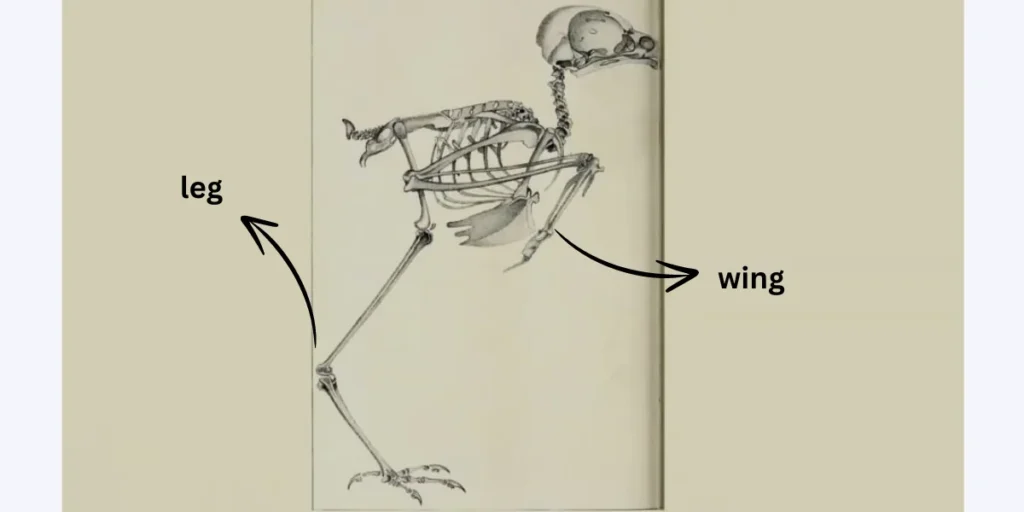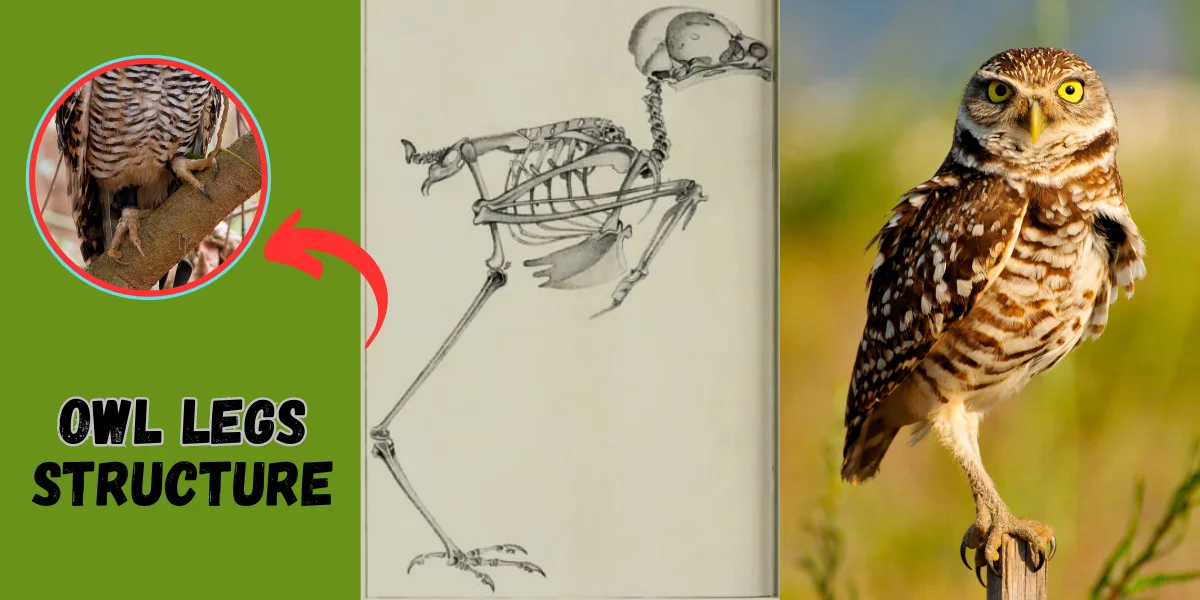Owl legs are unique and interesting parts of their body. When we think of owls, we often picture their big eyes and round faces, but their legs are just as important. Hidden under their feathers, owl legs are long and powerful, helping them to be great hunters. These legs allow owls to catch prey quickly and hold onto it tightly. Understanding more about owl legs gives us a better idea of how these amazing birds survive and thrive in the wild.
Owl Legs: Understanding Their Structure and Importance
Owl legs are long and powerful, designed for strength and precision. They have short, muscular thighs (femurs) close to their bodies, and long shin bones (tibiotarsus), giving them leverage for flying and hunting. The main visible joint is the ankle, not the knee, with their toes (tarsometatarsus) extending downward.

Owls possess sharp talons at the end of their toes, which are arranged in a zygodactyl pattern—two toes pointing forward and two backward. This allows them to grip prey firmly and perch securely on branches. Their legs are covered in feathers, offering warmth and protection, especially in cold environments. The unique structure helps them maintain silent flight and efficient landings.
The Hidden Strength of Owl Legs
When you look at an owl, you might not notice its legs right away. Their legs are covered with feathers, making them look short, but they are actually longer than they seem. The feathers keep their legs warm and safe, but underneath, their legs are long, strong, and perfect for hunting.
Why Are Owl Legs So Strong?
Owl legs are strong because they need to catch and hold onto their prey. The muscles in their legs are powerful, allowing them to grip their food tightly. These muscles also help them lift off the ground easily, making their legs important for flying.
Key Features of Owl Legs
| Feature | Description | Importance |
|---|---|---|
| Length | Hidden under feathers, longer than they appear | Provides strength for hunting and flying |
| Muscle Strength | Strong muscles in the legs | Allows for powerful grip and easy movement |
| Feathers | Covers the legs | Offers warmth and protection |
| Talons | Sharp claws at the end of legs | Essential for catching and holding prey |
The Role of Claws and Talons
At the end of an owl’s legs are sharp claws called talons. These talons are very strong and are used to catch and kill prey. When an owl swoops down on its target, it uses its talons to grip the animal tightly. The strength of these talons ensures that the prey cannot escape.
How Do Owls Use Their Talons?
Owls use their talons to grab and hold onto prey like mice, rabbits, and even other birds. Once they catch their food, their strong legs and talons keep the prey in place until the owl is ready to eat.
Talons of Owls
| Talon Feature | Description | Function |
|---|---|---|
| Sharpness | Very sharp and pointed | Helps in piercing and holding prey |
| Curvature | Strongly curved | Ensures a firm grip on prey |
| Size | Different sizes in different species | Adapted to the type of prey they hunt |
The Importance of Feathered Legs
Owl legs are usually covered with feathers, which might seem unusual. However, these feathers are important. They help keep the owl warm, especially in colder places. The feathers also make the legs look shorter, giving the owl a more compact look.
Why Do Some Owls Have More Feathers on Their Legs?
Some owls, like the Snowy Owl, have very thick feathers on their legs. This is because they live in cold areas and need extra warmth. The feathers on their legs help them survive in cold weather by keeping the heat close to their bodies.
Feather Coverage on Owl Legs
| Species | Feather Coverage on Legs | Reason |
|---|---|---|
| Snowy Owl | Thick, dense feathers | Insulation in cold environments |
| Barn Owl | Moderate feathering | Balance between warmth and movement |
| Great Horned Owl | Light feathering | Adapted to mild climates |
Silent Flight and the Role of Legs
One of the coolest things about owls is that they can fly silently. This silent flight is partly due to the way their legs and wings work together. Their legs help them land quietly, which is important when they are hunting.
How Do Owl Legs Help with Silent Flight?
The strong muscles in their legs allow owls to glide smoothly and land without making much noise. Their legs work together with their wings to ensure a quiet approach, making them great hunters, especially at night.
Owl Leg Adaptations for Silent Flight
| Adaptation | Description | Benefit to Silent Flight |
|---|---|---|
| Muscle Strength | Allows controlled landings | Reduces noise during landing |
| Joint Flexibility | Smooth movement with wings | Ensures a quiet approach |
| Feather Padding | Cushions impact during landing | Minimizes sound during landing |
Adaptation to Different Environments
Owls can be found all over the world, from forests to deserts. Their legs have adapted to help them survive in these different environments. For example, owls that live in trees have legs that help them perch securely, while ground-dwelling owls have legs that are better for walking or running.
What Makes Owl Legs Adaptable?
The structure and strength of owl legs make them adaptable. Their legs can handle different tasks, like gripping branches or running on the ground, making owls good at living in various habitats.
Environmental Adaptations of Owl Legs
| Habitat Type | Owl Species | Leg Adaptation | Function |
|---|---|---|---|
| Forest | Barred Owl | Strong, short legs | Gripping branches |
| Open Fields | Barn Owl | Longer legs | Catching prey in open spaces |
| Desert | Burrowing Owl | Legs adapted for walking and running | Mobility on the ground |
The Hunting Process and Owl Legs
When it comes to hunting, owl legs play a big role. Owls hunt mainly at night, using their legs to catch prey quickly and easily. Their legs must be strong and fast to succeed in the hunt.
Step-by-Step Hunting Process
- Spotting Prey: Owls use their sharp eyes to find prey, even in low light.
- Swooping Down: Once they see their target, they use their strong legs to push off and dive toward the prey.
- Grabbing with Talons: Their talons grab the prey tightly, and their legs hold it in place.
- Killing the Prey: With their strong legs, they apply enough pressure to kill the prey quickly.
- Carrying the Prey: Finally, they use their legs to carry the prey back to a safe place to eat.
The Role of Legs in the Owl’s Hunting Process
| Hunting Stage | Role of Legs | Importance |
|---|---|---|
| Spotting Prey | Stability during observation | Ensures clear vision without movement |
| Swooping Down | Power for takeoff | Enables a quick and smooth dive |
| Grabbing Prey | Strength and grip with talons | Secures the prey tightly |
| Killing Prey | Pressure applied through legs and talons | Ensures quick and easy kill |
| Carrying Prey | Transport using legs and talons | Allows owl to bring prey to a safe spot |
Owl Legs in Different Species
Different owl species have slightly different leg structures, depending on their lifestyle and habitat. For example, barn owls have longer legs for hunting in open fields, while forest-dwelling owls have shorter, stronger legs for gripping branches.
How Do Leg Structures Vary Among Owls?
- Barn Owls: Long legs help them catch prey in open spaces.
- Forest Owls: Strong, shorter legs help them perch and hunt in dense woods.
- Burrowing Owls: Their legs are adapted for walking and running on the ground.
Comparison of Leg Structures in Different Owl Species
| Species | Leg Length | Primary Function | Adaptation |
|---|---|---|---|
| Barn Owl | Long | Hunting in open fields | Swift movement to catch prey |
| Great Horned Owl | Medium | Perching and hunting in forests | Strong grip for holding onto branches |
| Burrowing Owl | Short | Walking and running on the ground | Mobility on flat surfaces |
Challenges Faced by Owl Legs
Like any other part of their body, owl legs can face problems. Injuries to their legs can affect their ability to hunt, fly, and survive. Knowing about these challenges helps in protecting owls and keeping them safe.
Common Problems with Owl Legs
- Injuries: Broken bones or cuts can be serious, making it hard for owls to hunt or escape danger.
- Cold Weather: In very cold places, even with feathers, owl legs can suffer from frostbite.
- Human Impact: Traps, wires, and pollution can hurt owl legs, leading to injury or even death.
Challenges to Owl Legs
| Challenge | Description | Impact on Owl |
|---|---|---|
| Injuries | Broken bones, cuts, or sprains | Reduced hunting and flying abilities |
| Cold Weather | Exposure to extreme cold | Risk of frostbite and reduced movement |
| Human Impact | Traps, wires, and pollution | Potential injury or loss of legs |
The Evolution of Owl Legs
Owl legs have changed over time to become the strong tools they are today. This evolution has allowed owls to live in different places and become some of the best hunters among birds.
How Have Owl Legs Evolved?
Over millions ofyears, owl legs have become longer, stronger, and more suited to different environments. This evolution has helped owls to thrive in many different habitats.
Evolutionary Changes in Owl Legs
| Evolutionary Trait | Description | Benefit to Owls |
|---|---|---|
| Increased Strength | Stronger muscles and bones | Better hunting and flying abilities |
| Feathered Coverage | Development of feathers on legs | Better warmth and camouflage |
| Adaptable Structure | Varies among species for different habitats | Improved survival in various environments |
Protecting Owls and Their Legs
Protecting owls means keeping their legs safe too. Efforts to conserve owls focus on protecting their homes and reducing threats like pollution and hunting. By understanding the importance of owl legs, we can better appreciate these amazing birds and work to keep them safe.

What Can We Do to Help?
- Conservation: Support efforts to protect owl habitats.
- Education: Learn about owls and share this knowledge with others.
- Responsibility: Avoid using harmful traps or chemicals that could hurt owls.
Conservation Efforts for Owl Protection
| Conservation Effort | Description | How It Helps Owls |
|---|---|---|
| Habitat Protection | Preserving forests, fields, and wetlands | Ensures safe places for owls to live |
| Public Education | Teaching people about owls and their needs | Reduces human-caused harm |
| Legal Protection | Enforcing laws against hunting and trapping | Keeps owls safe from injury and death |
Conclusion: The Importance of Owl Legs
Owl legs are not just a part of their body; they are important tools that help them survive. From hunting and flying to adapting to different environments, owl legs play a crucial role in an owl’s life. By understanding and appreciating these powerful legs, we can gain a deeper respect for owls and the incredible ways they have adapted to the world around them. Through conservation and education, we can help protect these remarkable birds and ensure that their legs, along with the rest of their bodies, continue to function at their best.

2 thoughts on “Owl Legs: Essential Facts, Functions, and Features”